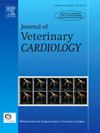Occurrence and distribution of left ventricular bands and normal anatomical features in 78 feline hearts
IF 1.3
2区 农林科学
Q2 VETERINARY SCIENCES
引用次数: 0
Abstract
Introduction/Objectives
Left ventricular bands (LVBs) are common in feline hearts. Their importance and general features are incompletely described. This study aimed to characterize LVBs in feline hearts based on anatomical location, quantity, histological features, and attachment sites.
Animals, Materials and Methods
Hearts from 78 domestic cats with or without heart disease were included in this study. Cardiac weight and dimensions were measured, and LVBs were categorized as singular bands or nets, with further characterization by location, length, appearance, and histological examination of attachment sites.
Results
Median cardiac weight was 4.34 g/kg (interquartile range: 2.1 g/kg). Left ventricular bands were present in all hearts, with 11% having only singular bands, 32% containing only nets, and 42% having nets covering the entire left ventricle (LV). The most common LVB attachment sites were the LV mid-region involving the posterior papillary muscle. Nets were most common in the mid-region including the papillary muscles (93%), followed by basilar (60%) and apical (59%) regions. All LVBs contained collagen, myocytes, adipose tissue, endothelial cells, and fibroblasts. No excess fibrosis, myocardial hypertrophy, or endocardial thickening at the attachment sites was identified.
Study Limitations
The study included mainly domestic stray cats aged 12 weeks to 15 years, with few purebred or diseased individuals. The hearts were examined by one person, which may introduce subjectivity.
Conclusions
Left ventricular bands are commonly found in the mid LV section of feline hearts, primarily involving the posterior papillary muscle, suggesting normal variation. Left ventricular bands contain myocytes, not Purkinje fibers, and are not fibrous tendons. Myocyte hypertrophy or excess fibrosis is absent at attachment sites.
78只猫左心室带的发生分布及正常解剖特征
导言/目的左心室带(LVB)在猫科动物心脏中很常见。对其重要性和一般特征的描述尚不完整。本研究旨在根据解剖位置、数量、组织学特征和附着部位来描述猫科动物心脏中 LVB 的特征。测量了心脏重量和尺寸,并将左心室带分为单个带状和网状,根据位置、长度、外观和附着部位的组织学检查进一步确定其特征。结果中位心脏重量为 4.34 克/千克(四分位间范围:2.1 克/千克)。所有心脏都存在左心室带,其中11%的心脏只有单个带,32%的心脏只有网状带,42%的心脏网状带覆盖整个左心室(LV)。最常见的左心室带附着部位是左心室中区,涉及后乳头肌。网最常见于包括乳头肌在内的中区(93%),其次是基底区(60%)和心尖区(59%)。所有 LVB 均含有胶原蛋白、肌细胞、脂肪组织、内皮细胞和成纤维细胞。研究局限性该研究主要包括年龄在 12 周到 15 岁之间的家养流浪猫,纯种猫或患病猫很少。结论左心室带常见于猫科动物心脏左心室中段,主要涉及后乳头肌,表明存在正常变化。左心室带包含肌细胞,而不是浦肯野纤维,也不是纤维腱。附着部位没有肌细胞肥大或过度纤维化。
本文章由计算机程序翻译,如有差异,请以英文原文为准。
求助全文
约1分钟内获得全文
求助全文
来源期刊

Journal of Veterinary Cardiology
VETERINARY SCIENCES-
CiteScore
2.50
自引率
25.00%
发文量
66
审稿时长
154 days
期刊介绍:
The mission of the Journal of Veterinary Cardiology is to publish peer-reviewed reports of the highest quality that promote greater understanding of cardiovascular disease, and enhance the health and well being of animals and humans. The Journal of Veterinary Cardiology publishes original contributions involving research and clinical practice that include prospective and retrospective studies, clinical trials, epidemiology, observational studies, and advances in applied and basic research.
The Journal invites submission of original manuscripts. Specific content areas of interest include heart failure, arrhythmias, congenital heart disease, cardiovascular medicine, surgery, hypertension, health outcomes research, diagnostic imaging, interventional techniques, genetics, molecular cardiology, and cardiovascular pathology, pharmacology, and toxicology.
 求助内容:
求助内容: 应助结果提醒方式:
应助结果提醒方式:


